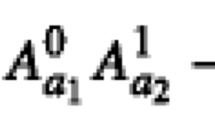Abstract
Nonlocality is an important resource for quantum information processing. Genuine tripartite nonlocality, which is sufficiently confirmed by the violation of Svetlichny inequality, is a kind of more precious resource than the standard one. The genuine tripartite nonlocality is usually quantified by the amount of maximal violation of Svetlichny inequality. The problem of detecting and quantifying the genuine tripartite nonlocality of quantum states is of practical significance but still open for the case of general three-qubit quantum states. In this paper, we quantitatively investigate the genuine nonlocality of three-qubit states, which not only include pure states but also include mixed states. Firstly, we derive a simplified formula for the genuine nonlocality of a general three-qubit state, which is a function of the corresponding three correlation matrices. Secondly, we develop three properties of the genuine nonlocality which can help us to analyze the genuine nonlocality of complex states and understand the nature of quantum nonlocality. Further, we get analytical results of genuine nonlocality for two classes of three-qubit states which have special correlation matrices. In particular, the genuine nonlocality of generalized three-qubit GHZ states, which is derived by Ghose et al. (Phys. Rev. Lett. 102, 250404, 2009), and that of three-qubit GHZ-symmetric states, which is derived by Paul et al. (Phys. Rev. A 94, 032101, 2016), can be easily derived by applying the strategy and properties developed in this paper.

Similar content being viewed by others
References
Bell, J.S.: On the Einstein Podolsky Rosen paradox. Physics 1(3), 195–200 (1964)
Brunner, N., Cavalcanti, D., Pironio, S., Scarani, V., Wehner, S.: Bell nonlocality. Rev. Mod. Phys. 86(2), 419–478 (2014)
Buhrman, H., Cleve, R., Massar, S., Wolf, R.D.: Nonlocality and communication complexity. Rev. Mod. Phys. 82(1), 665–698 (2010)
Bennett, C.H., Brassard, G., Mermin, N.D.: Quantum cryptography without Bells theorem. Phys. Rev. Lett. 68(5), 557–559 (1992)
Dhara, C., Prettico, G., Acin, A.: Maximal quantum randomness in Bell tests. Phys. Rev. A 88, 052116 (2013)
Barrett, J., Hardy, L., Kent, A.: No signaling and quantum key distribution. Phys. Rev. Lett. 95, 010503 (2005)
Clauser, J.F., Horne, M.A.: Proposed experiment to test local hidden-variable theories. Phys. Rev. Lett. 23(15), 880–884 (1969)
Brunner, N., Gisin, N., Scarani, V.: Entanglement and non-locality are different resources. New J. Phys. 7, 88 (2005)
Gisin, N., Peres, A.: Maximal violation of Bell’s inequality for arbitrarily large spi. Phys. Lett. A 162, 15–17 (1992)
Werner, R.F.: Quantum states with Einstein–Podolsky–Rosen correlations admitting a hidden-variable model. Phys. Rev. A 40, 4277–4281 (1989)
Horodecki, R., Horocecki, P., Horodecki, M.: Violating Bell inequality by mixed spin-1/2 states: necessary and sufficient condition. Phys. Lett. A 200, 340–344 (1995)
Svetlichny, G.: Distinguishing three-body from two-body nonseparability by a Bell-type inequality. Phys. Rev. D 35(10), 3066–3069 (1987)
Bancal, J.D., Barrett, J., Nicolas Gisin, N., Pironio, S.: Definitions of multipartite nonlocality. Phys. Rev. A 88, 014102 (2013)
Lavoie, J., Kaltenbaek, R., Resch, K.J.: Experimental violation of Svetlichnys inequality. New J. Phys. 11, 073051 (2009)
Ghose, S., Sinclair, N., Debnath, S., Rungta, P., Stock, R.: Tripartite entanglement versus tripartite nonlocality in three-qubit GHZ states. Phys. Rev. Lett. 102, 250404 (2009)
Ajoy, A., Rungta, P.: Svetlichny’s inequality and genuine tripartite nonlocality in three-qubit pure states. Phys. Rev. A 81, 052334 (2010)
Paul, B., Mukherjee, K., Sarkar, D.: Nonlocality of three-qubit Greenberger–Horne–Zeilinger-symmetric states. Phys. Rev. A 94, 032101 (2016)
Li, M., Shen, S., Jing, N., Fei, S., Li-Jost, X.: Tight upper bound for the maximal quantum value of the Svetlichny operators. Phys. Rev. A 96, 042323 (2017)
Su, Z.: Generating tripartite nonlocality from bipartite resources. Quantum Inf. Process. 16(2), 28 (2017)
Eltschka, C., Siewert, J.: Entanglement of three-qubit Greenberger–Horne–Zeilinger-symmetric states. Phys. Rev. Lett. 108, 020502 (2012)
Siewert, J., Eltschka, C.: Quantifying tripartite entanglement of three-qubit generalized Werner states. Phys. Rev. Lett. 108, 230502 (2012)
Acknowledgements
The author is delighted to thank Professor Yuan Feng for illuminating and fruitful discussions in the last four years which helps Zhaofeng to lay solid foundations for further research. This research is partially supported by National Key R&D Program of China (Grant No. 2016YFB0200602), Chinese Scholarship Council (Grant No. 201206270069), Australian Research Council (Grant No. DP160101652) and National Natural Science Foundation of China (Grant Nos. 61472452 and 61772565).
Author information
Authors and Affiliations
Corresponding author
Rights and permissions
About this article
Cite this article
Su, Z., Li, L. & Ling, J. An approach for quantitatively analyzing the genuine tripartite nonlocality of general three-qubit states. Quantum Inf Process 17, 85 (2018). https://doi.org/10.1007/s11128-018-1852-7
Received:
Accepted:
Published:
DOI: https://doi.org/10.1007/s11128-018-1852-7




